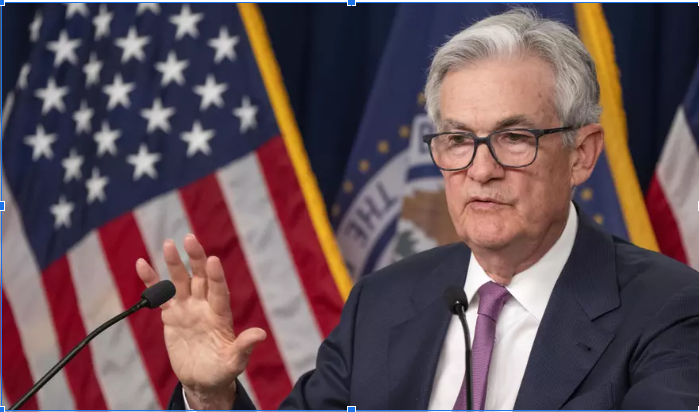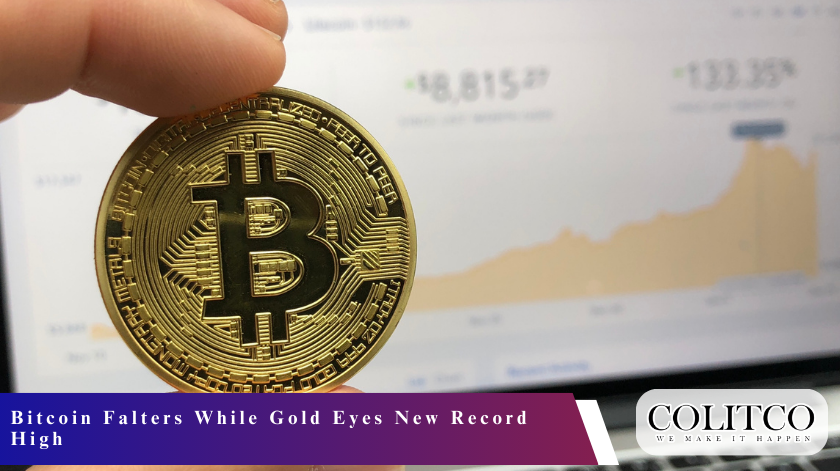Gold futures set an all-time high price, continuing to affirm its position as the safest asset to hold and widening its performance gap over Bitcoin in 2021. Although both assets have gained in 2025, the massive legacy of gold and its institutional backing have given it a clear edge in times when the macroeconomic environment is uncertain. This dynamic highlights the competition that exists between the traditional and digital store of value.
Gold’s Record-Breaking Ascent
Friday saw gold futures soaring to a record closing of 3,491.30 after which they slightly slipped back in electronic trading. This record is a year-to-year gain of 30.8, which is much higher than most of the major asset classes. The journey of the precious metal has been characterized by a steady rise in the trend, continuously registering new highs in the course of the year.
Its performance highlights a robust demand for traditional risk-off assets. Gold still had a wide lead even after shedding some of its gains. The strength of the metal is the strongest evidence of its lasting popularity. According to market analysts, this rally is caused by several factors. This, in turn, has given gold a lot of investor interest.
The trading session on the day depicted the volatile trend of gold, which was on an upward trend. Prices first jumped as a result of the prospect of U.S. tariffs on certain gold bars. They subsequently cut those profits after they heard that there was a potential exemption on imported bars.
This price behavior is a sign of the sensitivity of the market to the trade policy. But the underlying bullish mood was very strong. The safety of the metal was always in demand by investors. This act stimulates the value of gold in portfolios. In addition, it demonstrates that price fluctuations can occur immediately due to geopolitical decisions.
Bitcoin’s Struggle for Momentum
Bitcoin, however, was under pressure, falling 0.7 per cent. to trade at approximately 116,511. The cryptocurrency is about 5.4 percent under its record high of $123,165.67, recorded on July 14. Bitcoin has posted a decent HY increase of 24.6; however, it has fallen short of the steady gold.
This is a performance gap that has increased in the past few weeks. Bitcoin is tightening at the level of about 111,500 without a strong movement. Analysts notice that there is a dissimilarity in the investor action of the two assets.
There was a high degree of volatility in the crypto market. Etherium had momentarily hit a new all-time high and then withdrew. One of the biggest market actions happened when a big holder of Bitcoin, commonly known as a whale, disposed of a big portion.
This 24,000 BTC sell-off caused a flash crash on crypto exchanges. It caused hundreds and millions of dollars of liquidated leveraged positions. This incident showed that the market is still vulnerable to large-scale trades. It also highlighted the relative lack of maturity of the asset class against gold.
The Core Drivers of Gold’s Outperformance
There are a number of major reasons why gold has performed better this year. One of the greatest triggers has been high geopolitical tension. Investors have run to safe havens that have been proven in times of conflicts and trade wars. In addition, the issue of tariffs and inflationary impact has increased the attraction of gold.
The support of purchases by central banks has been extraordinary. Macroeconomic uncertainties have led to increased buying by institutions of gold in the world. The basis of the prices is established via this institutional demand.

Currency.com CEO Konstantin Anissimov described this trend. In a telephone interview, he said that the general theme is uncertainty. Sovereigns run away to that which they are familiar with, and that has passed the storms of millennia.
Many investment strategists share this mood. Its long history as a store of value, which is thousands of years old, is a credibility that new assets are not yet able to match. Its physical character and absence of a counterparty risk are also desirable features. Thus, during a crisis, the money moves to this priori asset.
Bitcoin’s Correlation with Risk Assets
One of the main problems that Bitcoin faces in shortening its safe-haven narrative is its correlation. Rob Haworth, the senior investment-strategy director at U.S. Bank Asset Management Group, reported this problem. He said in a phone interview that Bitcoin continues to move in tandem with risk assets.
This association restricts its suitability to the time of actual market uncertainty. Investors tend to avoid risky assets when they are worried about the possibility of a recession or a crash of market crash. Bitcoin has traditionally been in this category and has been an act more like a tech stock than a digital gold.
The market action reveals this in recent business. Spot Bitcoin ETFs have six days of outflows in a row with cumulative outflows amounting to $1.19 billion. This implies that there were institutional investors who were removing risk from the table.
Although the long-run adoption dynamics are encouraging, the short-run patterns of trade are usually consistent with the risk-on/ risk-off mood. This remains one of the headwinds to the argument of Bitcoin as a safe-haven. Unless this correlation can be decoupled, its effect can be more speculative than protective.
The Federal Reserve’s Pivotal Role
Monetary policy remains a dominant force for both assets. Lower interest rates typically benefit gold because they reduce the opportunity cost of holding it. Gold pays no interest or dividends. Therefore, when rates on bonds and savings accounts fall, gold becomes more attractive.
Recent economic data has fueled expectations for Federal Reserve rate cuts. Weaker job numbers and milder inflation reports have driven these hopes. This environment is a tailwind for gold prices.

Federal Reserve Chair Jerome Powell’s Jackson Hole remarks fueled speculation of imminent rate cutsc
Fed Chair Jerome Powell’s recent comments at Jackson Hole were closely watched. He opened the door to potential rate cuts, possibly starting in September. This initially boosted cryptocurrency prices as well. Bitcoin rallied near $117,200 following his speech.
However, this gain was quickly erased over the weekend. The market’s reversal suggests that crypto traders are still nervous about the Fed’s precise path. Powell’s nuanced tone left room for interpretation, creating uncertainty.
Institutional Adoption: A Key Divergence
A major divergence between gold and Bitcoin lies in institutional adoption. Gold enjoys universal acceptance among central banks and sovereign wealth funds. No major government, however, has adopted Bitcoin as a reserve asset.
There have been steps in this direction, such as former President Trump’s executive order to explore a federal Bitcoin reserve. Yet, concrete details and large-scale adoption are still lacking. This official recognition is a significant advantage for gold.
Conversely, corporate adoption of Bitcoin is growing. Anissimov noted that companies are increasingly adding cryptocurrency to their treasuries. This trend represents a powerful long-term demand driver.
Peter Eberle, president of Castle Funds, is optimistic about this institutional shift. “The capital flows from institutions to bitcoin are only at the beginning,” he said. He cited regulatory clarity and a friendlier administration as key catalysts. This gradual adoption could eventually support Bitcoin’s value proposition.
Market Outlook and Technical Perspectives
The technical outlook for both assets currently favors gold. Analysts at Currency Research Associates noted this in a recent report. Short-term momentum has turned negative for Bitcoin, they wrote. Meanwhile, it remains positive for gold.
This suggests potential for further gains in the precious metal in the coming week. From a chart perspective, gold’s trend is intact and upward-sloping. Bitcoin’s chart shows a consolidation pattern near its highs.
UBS Global Wealth Management has raised its price targets for gold. Strategists led by Wayne Gordon now expect prices to reach $3,600 per ounce by March 2026. They forecast a further rise to $3,700 by June 2026. Their bullish view is based on several factors. They cite U.S. macro risks, questions over Fed independence, and fiscal sustainability concerns. Geopolitics underpinning de-dollarization trends and central bank buying are also critical. “We therefore now forecast global gold demand to increase by 3% to 4,760 [metric tons] in 2025,” said Gordon’s team. This would be the highest level since 2011.
ETF Flows Highlight Investor Preference
Exchange-traded fund flows further illustrate the current preference. The popular SPDR Gold Shares ETF (GLD) is up 29% so far in 2025. The VanEck Gold Miners ETF (GDX) has gained an impressive 71% yearly.
These inflows indicate strong investor appetite for gold exposure. The World Gold Council reported the strongest first-half inflows into gold ETFs since 2010. This robust demand provides a strong foundation for continued price strength.
Bitcoin ETF flows have been more mixed recently. After a period of massive inflows, the products have seen significant outflows. This indicates some profit-taking or risk reduction among institutional players.
However, the long-term trend for Bitcoin ETF adoption remains positive. Their very existence marks a monumental shift in accessibility. Yet, in the short term, gold ETFs are capturing more safe-haven flows. This reflects a preference for stability amid uncertainty.
The Long-Term Narrative for Digital Gold
Despite recent underperformance, Bitcoin’s long-term narrative remains intact. Proponents still believe in its potential as “digital gold.” Its fixed supply and decentralized nature are compelling features.
As institutional infrastructure improves, its volatility may decrease. Eventually, this could allow it to function more effectively as a store of value. The journey toward that goal, however, is proving to be volatile and unpredictable.
Eberle of Castle Funds is an expression of this long-term optimistic opinion. In his opinion, Bitcoin can continue to rise more than gold since it is being adopted by institutions. It is at the first stage of institutional adoption, he added. This is the view of numerous crypto supporters.
According to them, the present price moves are temporary noise. They are confident that the long-term process of digitalization and monetary evolution will be in favor of Bitcoin. In the meantime, however, the market is, so to speak, voting for the tested asset.
Conclusion: A Battle of Proven vs. Potential
The monetary environment is quite different at present. Gold is prevailing in the safe-haven battle because it has been tried in a historical context and has emerged as a haven. It enjoys huge institutional backing and a flight to certainty.
Bitcoin remains an innovative and high-potential asset, but it acts as a risk asset. The fact that it correlates with equities and is volatile makes it an ineffective safe-haven. Gold is still the best investment option for those investors who are stable.
The trends in the market can imply that this trend can be maintained in the short term. A lot is left to be seen on the next moves of the Federal Reserve. The reduction in rates would strengthen both the assets and the dollar would be weakened.
Nevertheless, the movement of gold and its technical view are now stronger. To be a competitor to digital gold, Bitcoin would need to show a break with the risk-on mood. So far, the ancient metal is still the final haven. The struggle between established tradition and game-changer remains in progress.
Also Read: https://colitco.com/framer-valuation-series-d-100m-2-billion/
FAQs
- Why did gold reach its record high in 2025?
Gold is supported by geopolitical tensions, central-bank buying, and hopes of softer interest rates, all of which enhance its safe-haven appeal even further.
- How much has the gold price risen this year?
Gold futures have jumped about 30.8% so far this year, one of the best-performing of the major assets in 2025.
- How does Bitcoin perform relative to gold in 2025?
Bitcoin’s +24.6% YTD, though that lags behind gold’s ~31% spike.
- Why is gold a safe-haven asset?
Gold’s got 5,000 years of monetary history, no counterparty risk, and is nearly universally accepted, making it covetable when things are uncertain.
- Why is Bitcoin sometimes called “digital gold”?
Because it has a limited supply (21 million coins) and decentralization, Bitcoin is seen by many as a digital store of value akin to gold.
- Why did Bitcoin recently fail?
A large “whale” sold 24,000 BTC, triggering a flash crash and more than $800 million worth of leveraged liquidations, exposing crypto volatility.
- Does Bitcoin continue to trade with tech stocks?
Yes. Pundits note that Bitcoin is apt to follow risk assets like the Nasdaq, limiting its safe-haven character.
- How do Federal Reserve actions affect gold and Bitcoin?
Federal Reserve rate cuts are set to boost gold (less opportunity cost) and can also lift Bitcoin, although crypto reactions are more unpredictable and lopsided.
- Are central banks buying Bitcoin when they buy gold?
No. Central banks continue to add gold but have not adopted Bitcoin as a reserve asset.
- How have ETFs contributed to the rally in gold?
Gold ETFs like GLD and GDX have seen heavy inflows in 2025, reflecting investor appetite for stability.
- How are Bitcoin ETFs performing?
They saw record inflows initially, but in recent times, some outflows were seen as institutions cut back on risk.
- Can Bitcoin ever hope to rival gold as a reserve asset?
Maybe in the long term, when institutional investment increases and volatility ebbs, but gold’s reputation gives it an edge in the meantime.
- Which asset is a more effective hedge against inflation?
Gold continues to be viewed as the safer choice as a hedge, but Bitcoin enthusiasts think that its limited supply makes it a good long-term inflation shield.
- Is gold’s gain related to U.S. tariffs?
Yes. Fears over tariffs have contributed to the attractiveness of gold, though short-term price fluctuations were caused by temporary import exemptions.
- How high is gold going to go from here?
UBS forecasts gold to increase to $3,700 an ounce by June 2026, supported by de-dollarization and central bank buying.
- Is volatility in Bitcoin slowing down?
Partially, yet flash crashes and trading by “whales” show it still is much more volatile than gold.
- Do both assets benefit from dollar weakness?
Yes. A lower dollar prices gold for overseas buyers and also tends to elevate Bitcoin prices.
- Must investors own both Bitcoin and gold?
Many strategists recommend diversification: gold as a source of stability, Bitcoin as a source of appreciation and digital exposure.
- What are the biggest threats to gold investors?
Rising interest rates, surprise ETF outflow, or weakening central-bank demand can constrain gold gains.
- What are the biggest threats to Bitcoin investors?
Regulatory overkill, exchange vulnerabilities, and big whale activity that causes catastrophic crashes.












